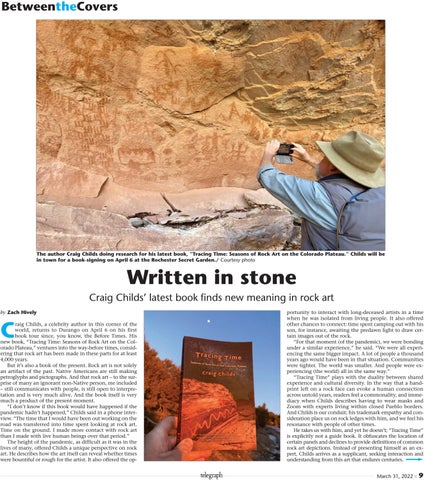BetweentheCovers
The author Craig Childs doing research for his latest book, ”Tracing Time: Seasons of Rock Art on the Colorado Plateau.” Childs will be in town for a book-signing on April 6 at the Rochester Secret Garden./ Courtesy photo
Written in stone Craig Childs’ latest book finds new meaning in rock art by Zach Hively
portunity to interact with long-deceased artists in a time when he was isolated from living people. It also offered other chances to connect: time spent camping out with his son, for instance, awaiting the predawn light to draw certain images out of the rock. “For that moment (of the pandemic), we were bonding under a similar experience,” he said. “We were all experiencing the same bigger impact. A lot of people a thousand years ago would have been in that situation. Communities were tighter. The world was smaller. And people were experiencing (the world) all in the same way.” “Tracing Time” plays with the duality between shared experience and cultural diversity. In the way that a handprint left on a rock face can evoke a human connection across untold years, readers feel a commonality, and immediacy when Childs describes having to wear masks and Zoom with experts living within closed Pueblo borders. And Childs is our conduit; his trademark empathy and consideration place us on rock ledges with him, and we feel his resonance with people of other times. He takes us with him, and yet he doesn’t; “Tracing Time” is explicitly not a guide book. It obfuscates the location of certain panels and declines to provide definitions of common rock art depictions. Instead of presenting himself as an expert, Childs arrives as a supplicant, seeking interaction and understanding from this art that endures centuries.
C
raig Childs, a celebrity author in this corner of the world, returns to Durango on April 6 on his first book tour since, you know, the Before Times. His new book, “Tracing Time: Seasons of Rock Art on the Colorado Plateau,” ventures into the way-before times, considering that rock art has been made in these parts for at least 4,000 years. But it’s also a book of the present. Rock art is not solely an artifact of the past. Native Americans are still making petroglyphs and pictographs. And that rock art – to the surprise of many an ignorant non-Native person, me included – still communicates with people, is still open to interpretation and is very much alive. And the book itself is very much a product of the present moment. “I don’t know if this book would have happened if the pandemic hadn’t happened,” Childs said in a phone interview. “The time that I would have been out working on the road was transferred into time spent looking at rock art. Time on the ground. I made more contact with rock art than I made with live human beings over that period.” The height of the pandemic, as difficult as it was in the lives of many, offered Childs a unique perspective on rock art. He describes how the art itself can reveal whether times were bountiful or rough for the artist. It also offered the op-
telegraph
March 31, 2022 n
9




